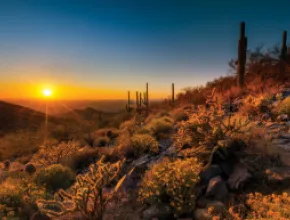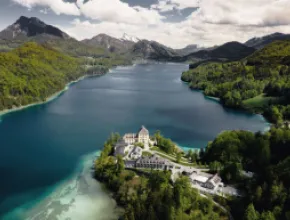Despite economic jitters in the U.S. and around the world, mountain destinations in the Western U.S. and Canada are expecting more meeting groups and individual travelers to head to their snowy slopes and to see growth in hotel and resort occupancies this upcoming winter season.
“What we are seeing, despite the uncertainty in the overall political and economic marketplace, are advance reservations that continue to look strong,” says Ralf Garrison, director of MTRIP, a Colorado-based destination travel research company that specializes in mountain resorts. “Three years into the Great Recession, we are seeing a continued growth in occupancy year over year.”
Last winter season, defined as the period from November through April, occupancies at Western U.S. mountain destinations were up 6 percent over the previous year, according to MTRIP surveys of 250 property management companies in the region. With advance bookings for this coming winter season strong, occupancies could approach the pre-recession levels of the 2007-08 season, according to Garrison.
“Overall, it looks like we may see between a 5 percent and 10 percent increase in occupancy over last year,” he says, noting that there could be wide differences among resorts and among destinations. “There is and continues to be a larger variance between winners and losers. While the average is increasing, destinations and individual properties within the destinations could be very different. Darwin is not being level-handed in the way we are coming out of this recovery.”
Good Value
However, even with bookings up at mountain resorts, travelers remain price conscious and stimulated by value, Garrison says. He also believes room rates will be flat and aggressive marketing by mountain resorts will be necessary.
“Those lodging properties that are trying to return to the prices of old are not being successful,” he says. “It still takes a good value and aggressive marketing to win the business. The economy is not giving us inherent demand.”
The building spurt of 2008-2010 in mountain destinations is probably over for a while. It was a result of an ambitious outlook during the strong real estate market five to eight years ago when planning began for new properties, many of them in the luxury sector.
“The building of those properties was ill-timed because of the real estate development cycle, which is four years long,” Garrison says. “The strong real estate market through 2007 begat a host of luxury properties and that inventory began to show up in 2009 and 2010. There’s been an increase in luxury supply and it has come at a time when the market has had to be frugal.”
As a result, the luxury properties have “been challenged,” Garrison notes, and are offering lower rates than originally envisioned, which has put pressure on three- and four-star resorts struggling to compete with the high-end newcomers. Also putting pressure on the entire mountain resort sector is a growth of the “rent-by-owner” business in which consumers who own vacation homes increasingly turn them into rental properties, adding inventory to a difficult-to-track “gray” market, he says.
According to Garrison, groups and meetings are more welcome at mountain resorts in winter than ever.
“Meeting planners have found themselves treated as a fair-weather friend,” he says. “When times are not so good, such as the last two years, which have been tough, the meeting planner has become more appreciated. They should continue to find good deals from a price standpoint, but they should lock up rates early.”
Two types of mountain resorts are doing better than others: those in close proximity to major population centers and those with well-known names.
“The local and regional drive markets have been a nice solace for those destinations,” Garrison says, adding that well-known destinations are also doing well. “There appears to be importance in the strength of a brand name. Those that are well known are enduring, their brand works like a magnet.”
Park City Perks
In Utah, Tonya Sweeten, meetings and conventions sales and marketing manager for the Park City CVB, says that bookings are strong for the coming season.
“Our rooms are filling up faster than they did last season and a couple of properties I spoke with say that booking windows are lengthening somewhat,” she says. “People are planning further out.”
At the Grand Summit Hotel, which has 15,000 square feet of meeting space, a new meeting venue will be available this winter: The Cabin, a former restaurant turned into meeting and event space with rustic lodge-style decor.
According to Sweeten, The Cabin is one indication that meetings business is looking up for Park City as properties increasingly cater to groups.
“Corporations are able to spend more money,” she says. “They’ve got more in their budgets for meetings. 2011 will be stronger than last year. We’re seeing DMCs start to come back after they practically died in 2008. And we’re getting more leads.”
Olympic Gold
Mountain resorts in Western Canada are also bullish on the upcoming season. Victoria Dyson, director of sales and marketing for the Fairmont Chateau Whistler in British Columbia, says that there are “positive indicators” that the 2011-12 winter will be an improvement over last year.
“Last year was a little disappointing,” she says. “We were still struggling with the Olympics hangover, which is typical for an 18-month period after hosting the Olympics.”
According to Dyson, meeting planners tend to avoid a destination when it hosts a major event such as the Olympics, typically for a year or two prior to the event as it prepares to host.
“And then it sort of falls off the radar and people don’t think about it,” she says.
While the “hangover,” coupled with the weak economy in the U.S., led to two challenging winter seasons, Dyson says “there are some great positive indicators out there” for the upcoming season, including bookings for corporate meetings and international visitors.
Whistler has lots of new venues for planners to use, including Olympics Plaza and many indoor and outdoor venues built for the Olympics.
“All of these new venues are helping us sell Whistler as a meetings destination,” Dyson says. “We’re a very logical choice because of the facilities that we’ve got.”
Historically, meeting planners may not have considered Whistler as a winter meeting destination but that has changed, she notes.
“Ten or 15 years ago meetings weren’t as big a part of our marketing,” Dyson says. “There aren’t any more five-night minimums, for instance. Groups are our bread-and-butter and we want them all year round.”
Planners may be surprised by the favorable rates, she adds.
“There’s more flexibility,” she says. “With the Canadian dollar strong we want to make sure the value is there when try to get Americans to cross the border so we are pricing accordingly. Meeting budgets are still tight and the bottom line is still the focus. We understand that and want to help planners make a smart choice for their organization.”
Laura Del Rosso has been writing for travel industry publications for over 20 years and is the author of Great Escapes: Northern California.






